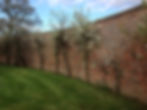Carmel of the Annunciation
History
Our monastery is built on the site of a 12th-century monastery of Cistercian nuns which was dissolved at the Reformation. The name Thicket Priory dates from this foundation. There is evidence of a local devotion to Our Lady of Thicket associated with this monastery.
Our Carmelite Order takes its name from Mount Carmel in Palestine where the first Carmelites, a group of hermits, lived in the early 13th-century. The Carmelite hermits came to England in 1242 and developed into an order of mendicant friars (begging brothers). At this time there were no Carmelite nuns as such but we do know of many lay people - including women - who had varying degrees of affiliation to the Order.
In continental Europe communities of Carmelite women were given formal recognition in 1452 by the Papal bull Cum Nulla. In the 16th Century a new form of living was introduced into the Carmelite Order by the great Spanish reformer, St Teresa of Avila. Teresa wanted to establish communities of about a dozen sisters who would combine the hermit spirit of the first Carmelites with a joyful community life.






In 1878 the Discalced Carmelite nuns of Paris established a monastery in the Notting Hill district of London. In turn Notting Hill Carmel founded many monasteries across Britain at a time of numerous religious foundations and new vocations, including our community, founded at Exmouth, Devon, in 1926. Our foundress was Mother Mary of Jesus, prioress of Notting Hill Carmel, who personally founded over 30 Carmelite monasteries in Britain.
By the 1950s it had become clear that the site of the Carmel in Exmouth was no longer suitable, with a new main road to be built very close to the monastery. The Prioress, Mother Mary of Saint-John Vavasour, came from Yorkshire - her family home had been Hazlewood Castle. She felt drawn to relocate the community to the north of England. After a long search, the sisters found a new home at Thicket Priory, moving in 1955 from Devon to Yorkshire. The story of the move to Thicket is told in the book Countryside And Cloister by Marie T. Litchfield.
Thicket had belonged to Lt. Col. Sir John Dunnington-Jefferson and Lady Isobel Dunnington-Jefferson, who generously offered their beautiful Victorian manor house and extensive garden to the sisters in return for only the proceeds from the sale of the small Exmouth Carmel (far less than the market value). In the 1970s Rt. Rev. William Wheeler, the Bishop of Leeds, wanted a community of Carmelite nuns within his diocese, thus in 1969, in the wake of the Second Vatican Council, eight sisters from Thicket made a foundation at Wood Hall near Wetherby.
In 2006, we began to realise that our monastery was becoming too large for us to maintain. We decided that we did not want to leave the area, but knew that we should move whilst we had the energy and ability to do so. After a long period of prayer, discussion and discernment a creative solution was found. The old house and part of the surrounding land was sold as a private residence, and we could then build a new monastery on the land we had retained, within the walls of what had been the Victorian vegetable garden. The pear trees along the eastern curved wall behind the chapel are over 150 years old. The ruins you see as you enter the walled garden belonged to an early 18th-century house on the site, which is thought to have been destroyed by a fire. The surviving South-West corner was later incorporated into the vegetable garden wall.
The new monastery at Thicket, designed by architects MacNeil, Beechey, O'Neill (MBO) of York, incorporates many "green" features which make it a model of how we can live in harmony with creation.
A cross on the lawn marks the burial site of the bones of the Cistercian nuns who lived in the original Thicket Priory. We discovered while building our new monastery for fifteen sisters that the Cistercian monastery had choir stall for fifteen sisters. They numbered twelve at the time of the Dissolution, and in 2009 when we took possession of our new monastery building, our community also numbered twelve.





